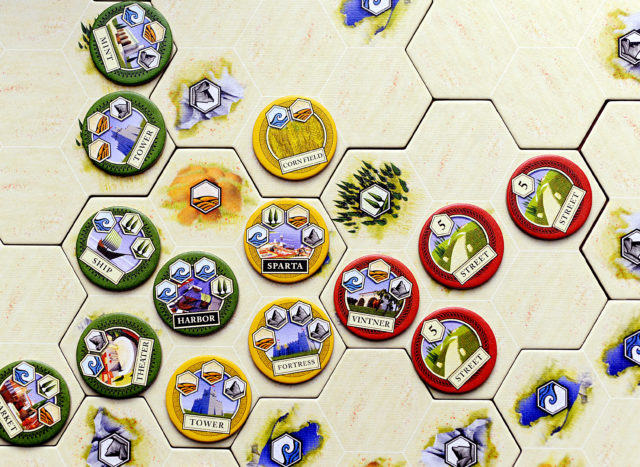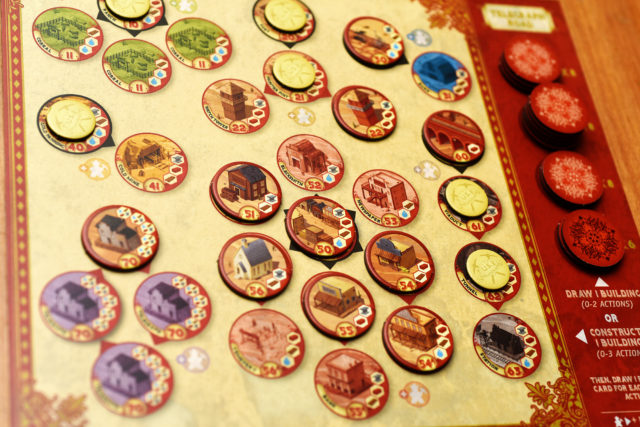Back in the day at Snakes & Lattes, when things were slow, we’d grab games off the shelf and teach them to each other or learn them together. I still remember one uncharacteristically quiet evening, when my friend Adam asked if I had ever played Attika and his horror to hear that I hadn’t. We sat down and banged it out, and it immediately became one of my favourite titles of all time. Originally published in 2003, it had been long out of print, but Adam on top of being a collector of games was specifically a collector of copies of Attika and he kindly gifted me one of the four he had on his shelves at the time.
Over the years, I’ve taken as much pleasure as he did introducing the game to new people. See, Attika isn’t a super flashy title. You play as leaders of ancient Greek cities revealing building tiles and playing them out on a main board. The goal is to get all 30 of your building tiles out on the board first, or to score an early victory by creating a chain of your buildings on the board between two temples.

Recently, Super Meeple has published U.S. Telegraph, which, make no mistake about it, is Attika. Sure the landscape of Greece has been swapped out for a wild west motif, but the gameplay remains the same. It’s 1860 and the Transcontinental Telegraph network is just being set up in the United States. You take on the role of investors looking to complete all of your projects first or to connect two cities with your projects.
You get your own player board to house the different projects you’re working on and store the different building tiles before they’re flipped. Building tiles are either black-backed (what I’d consider parent buildings) or white-backed. At the start of the game, you dived them into three equally sized white-backed stacks, and one black-backed stack. The main board is constructed with interlocking region tiles, and cities are placed at the corners. The shape and number of region tiles used in the setup is determined by the number of players.
One of the reasons Attika is so great is that the entire ruleset is displayed on your personal board, and the same is true for U.S. Telegraph. On your turn you can either Draw from your stacks of black and white buildings. If you choose to do that, you get two actions. You can either place them directly on the main board (paying their construction cost) or onto their designated space on your personal board for construction later. You can choose to Construct, giving you three actions for the turn. Constructing allows you to place revealed buildings from your personal board onto the main. Each building has a cost in resources to place out. You can cover those by playing cards form your hand, but certain spots on the main board produce resources and you can use them by building on top or next to them. You must build next to one of your existing buildings on the board or you pay a penalty for each different separate grouping you have on the board.

You can give up any number of your actions to instead just draw resource cards. They definitely come in handy, and likely more than once a game, you’ll spend an entire turn just drawing cards.
I mention that the black-backed buidlings are like parent buildings and the reason is that once they are built on the board, you can build other buildings beside them without paying for the cost. Sometimes you can chain several buildings at once in this way.
The buildings are broken up into projects on your personal boards. Each project has a parent building and a number of white backed ones. In U.S. Telegraph, for example, if you build the Ranch, you can build up to three Corals next to it for free. The Fields grant you the barn beside it, Probably the most important parent tile is your Main Street. A whole bunch of crud can be built off of it, and finding it early can be a big help.
When you complete a project, you get to take a Worker from the supply. These can be used to give you an extra action in a round. You can spend multiple Workers on a turn if you have them.

The board tends to fill up faster than you expect with buildings, and pretty soon, space will become a premium. Not to worry, when you exhaust one of your four piles of Building tokens, you draw and add a Region tile to the board. This provides an opportunity to get around a blocking opponent, or just plop down some resources in easy access of you.
Games tend to either end quick with a player making a city connection, or they become a race to getting your 30 Buildings on the board. Realizing when that’s the case is important.
Attika, and now U.S. Telegraph are great games. I really enjoy the simplicity of the rules and yet deep decisions you have to make. The main board is randomly created from Region tiles each game and the order you reveal your tiles will vary, so every time you play you’re solving a new puzzle. This new version has nice art, and the Building and Regions tiles are thick, solid cardboard. Best of all, you can reliably buy U.S. Telegraph. I really recommend this great new version of one of my favourite games.
—————————
A media copy of U.S. Telegraph was provided for this article by Super Meeple and Luma Imports.
Comments
No comments yet! Be the first!